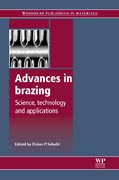
Brazing processes offer enhanced control, adaptability and cost-efficiency in the joining of materials. Unsurprisingly, this has lead to great interest and investment in the area. Drawing on important research in the field, Advances in brazing provides a clear guide to the principles, materials, methods and key applications of brazing.Part one introduces the fundamentals of brazing, including molten metal wetting processes, strength and margins of safety of brazed joints, and modeling of associated physical phenomena. Part two goes on to consider specific materials, such as super alloys, filler metals for high temperature brazing, diamonds and cubic boron nitride, and varied ceramics and intermetallics. The brazing of carbon-carbon (C/C) composites to metals is also explored before applications of brazing and brazed materials are discussed in part three. Brazing of cutting materials, use of coating techniques, and metal-nonmetal brazing for electrical, packaging and structural applications are reviewed, along with fluxless brazing, the use of glasses and glass ceramics for high temperature applications and nickel-based filler metals for components in contact with drinking water.With its distinguished editor and international team of expert contributors, Advances in brazing is a technical guide for any professionals requiring an understanding of brazing processes, and offers a deeper understanding of the subject to researchers and engineers within the field of joining. Reviews the advances of brazing processes in joining materialsDiscusses the fundamentals of brazing and considers specific materials, including super alloys, filler metals, ceramics and intermetallicsBrazing of cutting materials and structural applications are also discussed INDICE: Part 1 Fundamentals of brazing: The wetting process in brazing; Strength and margins of brazed joints; Modeling of the sequence phenomena in brazing. Part 2 Materials used in brazing: Brazing of superalloys and intermetallic alloys; High temperature brazing: Filler metals and processing; Brazing of diamonds and cubic boron nitride; Brazing of oxide, carbide, nitride and composite ceramics; Brazing of nickel, ferrite and titanium-aluminum intermetallics; Brazing of aluminium and aluminium to steel; Controlled atmosphere brazing of aluminum; Active metal brazing of advanced ceramic composites to metallic systems; Brazing of metal and ceramic joints; Brazing of carbon-carbon (C/C) composites to metals. Part 3 Applications of brazing and brazed materials: Brazing of cutting materials; Coating techniques using brazing; Metal-nonmetal brazing for electrical, packaging and structural applications; Glasses and glass ceramics as brazing materials for high temperature applications; Brazing of nickel-based filler metals for pipes and other components in contact with drinking water; Fluxless brazing of aluminium.
- ISBN: 978-0-85709-423-0
- Editorial: Woodhead Publishing
- Encuadernacion: Cartoné
- Páginas: 628
- Fecha Publicación: 04/03/2013
- Nº Volúmenes: 1
- Idioma: Inglés
